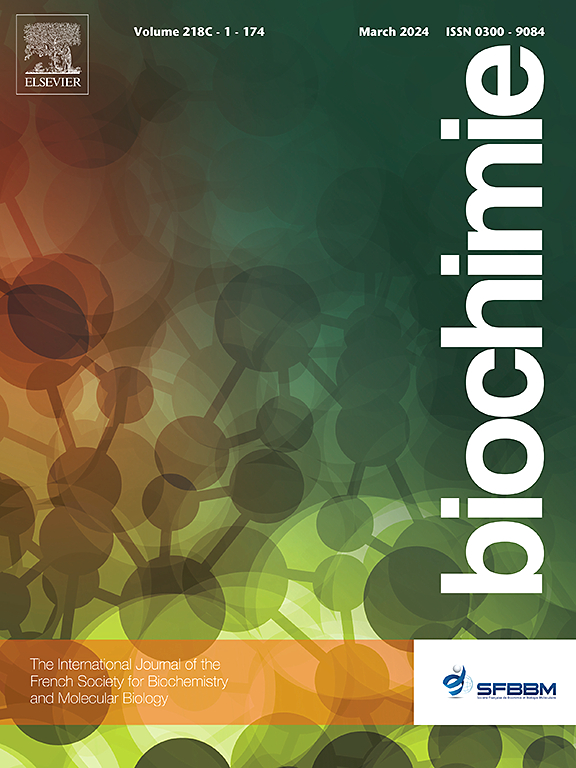Leishmania (Viannia) braziliensis Thor strain and subpopulations Thor03, Thor10, and Thor22 have differences in the surface membrane proteases activity profile
IF 3
3区 生物学
Q2 BIOCHEMISTRY & MOLECULAR BIOLOGY
引用次数: 0
Abstract
The Leishmania (Viannia) braziliensis Thor strain is composed of subpopulations with distinct biological features, as differences of the virulence profile in vitro and in vivo in murine model. As the surface of these parasites is the first contact with the host, this study assesses comparative approaches of surface membrane proteases of promastigotes and axenic amastigotes of L. (V.) braziliensis Thor strain and Thor03, Thor10, and Thor22 subpopulations, accessing differential profiles among these parasites. Here is explored the phospholipase C (PLC) property as a pivotal tool to selectively recover surface proteases of these parasites. The treatment of parasites with PLC yielded protein fractions with metalloprotease, cysteine protease, and serine protease activities, which were detectable by gelatin-SDS-PAGE and fluorogenic substrates and specific inhibitors, showing distinct profiles from both promastigotes and axenic amastigotes of the Thor strain, Thor03, Thor10, and Thor22 subpopulations. Data of protease activity quantitative in solution show metalloprotease as the highest activity, followed by cysteine protease and serine protease onto the surface of promastigotes and axenic amastigotes. The biological significance of these findings points to the potential of the Thor strain, helped by respective subpopulations, to adapt to hosts, as well as reinforcing the importance of this class of enzyme in the first hours of infection.
巴西利什曼原虫(Viannia) Thor菌株及其亚群Thor 03、Thor10和Thor 22在表面膜蛋白酶活性谱上存在差异。
巴西利什曼(Viannia) Thor菌株是由具有不同生物学特征的亚群组成的,在小鼠模型中具有不同的体外和体内毒力谱。由于这些寄生虫的表面是与宿主的第一次接触,本研究评估了巴西L. (V.) brasiliensis Thor菌株的promastigotes和axenic amastigotes以及Thor03、Thor10和Thor22亚群的表面膜蛋白酶的比较方法,以获得这些寄生虫之间的差异谱。本文探讨了磷脂酶C (PLC)作为选择性恢复这些寄生虫表面蛋白酶的关键工具的性质。用PLC处理寄生虫,得到了具有金属蛋白酶、半胱氨酸蛋白酶和丝氨酸蛋白酶活性的蛋白质片段,这些蛋白质片段可以通过明胶sds - page、荧光底物和特异性抑制剂检测到,显示出与Thor菌株、Thor 03、Thor 10和Thor 22亚群的promastigotes和axenic amastigotes不同的特征。溶液中蛋白酶活性定量数据显示,金属蛋白酶活性最高,其次是半胱氨酸蛋白酶和丝氨酸蛋白酶。这些发现的生物学意义表明,在各自亚群的帮助下,托尔菌株具有适应宿主的潜力,并在感染的最初几个小时内加强了这类酶的重要性。
本文章由计算机程序翻译,如有差异,请以英文原文为准。
求助全文
约1分钟内获得全文
求助全文
来源期刊

Biochimie
生物-生化与分子生物学
CiteScore
7.20
自引率
2.60%
发文量
219
审稿时长
40 days
期刊介绍:
Biochimie publishes original research articles, short communications, review articles, graphical reviews, mini-reviews, and hypotheses in the broad areas of biology, including biochemistry, enzymology, molecular and cell biology, metabolic regulation, genetics, immunology, microbiology, structural biology, genomics, proteomics, and molecular mechanisms of disease. Biochimie publishes exclusively in English.
Articles are subject to peer review, and must satisfy the requirements of originality, high scientific integrity and general interest to a broad range of readers. Submissions that are judged to be of sound scientific and technical quality but do not fully satisfy the requirements for publication in Biochimie may benefit from a transfer service to a more suitable journal within the same subject area.
 求助内容:
求助内容: 应助结果提醒方式:
应助结果提醒方式:


